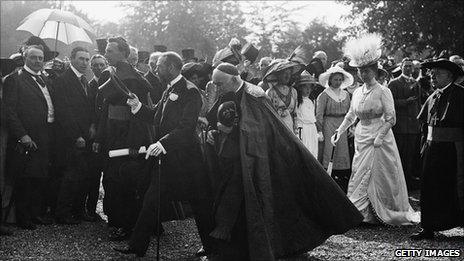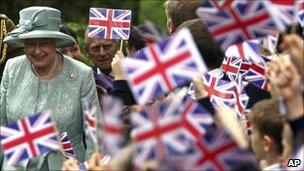Queen in Ireland: Chequered history behind visit
- Published

King George V was the last British monarch to visit Ireland - in 1911
As the Queen prepares for her four-day state visit to Ireland on Tuesday, BBC royal correspondent Nicholas Witchell explores the chequered history between the British monarchy and its neighbour.
The relationship between the Crown and Ireland has been one of the longest and most difficult in the history of Britain's monarchy.
Indeed attitudes to the Crown have been a defining, sometimes contradictory, and at times almost obsessive feature in the development of the Irish state.
Let us apply some definitions here. "The Crown" is the presence which, to very many generations of Irish people, came to symbolise the subjugation of their lands by distant and uncaring governments in London.
'Merciless exploitation'
Those governments presented themselves as "His Majesty's" or "Her Majesty's" governments.
The ever-present agents and enforcers of those governments always acted in the name of the King or Queen.
Very occasionally, those Kings and Queens would arrive with immense pomp and circumstance to inspect their Irish territories.
This is how it was for centuries. The first King who arrived with his armies across the Irish Sea from England was Henry II in 1171.
Nearly 400 years later, in 1541, Henry VIII became the first King of England also to pronounce himself "King of Ireland".
There followed centuries of what even the most committed Anglophile must surely accept was often merciless exploitation and cruelty (some deliberate, much through sheer negligence).
Millions of Irish people were either driven from their lands or driven to their deaths.
It was under Britain's longest-reigning monarch, Victoria, that Ireland suffered the terrible famines of the mid-19th Century when the potato crops failed and an estimated one million people starved to death.
And it was during Victoria's reign that the first real stirrings of Irish nationalism were felt.
The monarch, as the embodiment of the British state, became one of the targets of Irish hostility.
'Absentee landlords'
Of the seven attempts which were made on the life of Queen Victoria, three are said to have been carried out by Irishmen.
And yet, here we come to the contradictory nature of the relationship - Victoria visited Ireland on four occasions during her 63-year reign.
The rarity of such visits (to say nothing of their brevity: the four visits lasted, in total, just five weeks) underlined the impression that the British ruling classes were glorified "absentee landlords" when it came to Ireland.
Gerry Adams, leader of Sinn Fein: "Royal visit to the Republic of Ireland provides unique opportunity"
And yet, when she did visit, the British monarch was almost always received with enthusiasm.
On her second visit, in 1853, an estimated one million people turned out in the Dublin area to greet her.
Nearly 50 years later, in April 1900, when she paid her fourth and final visit to Ireland, she was again welcomed with something akin to rapture, despite by then urging her governments to adopt the sternest possible measures to suppress Irish nationalism.
She proceeded into Dublin in an open carriage, escorted by her mounted cavalry, the Lifeguards.
Her private secretary, Sir Frederick Ponsonby, wrote in his journal: "Although I had seen many visits of this kind, nothing had ever approached the enthusiasm and even frenzy displayed by the people of Dublin."
Eleven years later, Victoria's grandson, King George V, became the last British king to visit Dublin.
Revolution
Of all Britain's recent monarchs, George was perhaps the one who felt the greatest empathy and concern with Ireland. Its fate preoccupied him.
When he and Queen Mary departed from Dublin after a triumphant visit, he wrote: "Wherever we have gone, we have been welcomed with a spontaneous and hearty loyalty that has greatly touched our hearts… we shall never forget it."
George V had hoped to return to Ireland. But within years of his 1911 visit, the world was to change.

History is central to understanding the significance of Queen Elizabeth II's visit
The continent of which Britain and Ireland are both a part was to be convulsed by the Great War.
And within Ireland there was the, by now, unstoppable momentum of a revolution against the Crown.
The Easter Rising of 1916; the Irish War of Independence; these were the outbursts of a population driven to violent insurrection by the perceived failings of a form of government which had the British Crown at its apex.
In 1922, the Irish Free State became a self-governing British dominion. Six of the northern counties of Ireland were given the right to remain part of the United Kingdom.
They chose to exercise this right, and so "partition" came about, thus storing up further bitterness which still finds its tragic expression today.
But a status as an independent British dominion, similar to Canada and Australia, was not sufficient for nationalist Ireland.
Members of the Irish parliament still had to swear an oath of allegiance to the British monarch. After so many centuries of harsh treatment, this was felt to be intolerable.
'Perceived betrayals'
In 1937, the Irish political leader Eamon de Valera introduced the new Constitution of Ireland which established the office of president of Ireland who, supposedly, replaced the British monarch as Ireland's head of state.
Arguably, though, in law this was not the case, and it was not until the Irish parliament passed the Republic of Ireland Act in 1948 that the link with the Crown was finally broken.
Only at that point, technically, did the British monarch cease to have a role in Ireland which, henceforth, was to be regarded as a republic.
History, then, is absolutely central to understanding the significance of the visit by Elizabeth II to the Republic of Ireland (or, returning to our definitions, simply "Ireland", as the Irish Supreme Court has insisted it should be called).
Our two countries share a language and a land border, and so much else. Yet both nations have been scarred by the perceived betrayals of the other.
Ireland by the brutality of British rule; Britain by the neutrality of Ireland at its hour of greatest need in World War II.
They are the enmities which can arise between neighbours when the relationship has gone terribly wrong.
It is within that context - nearly 900 years since the first English king went to Ireland as an invader, and 100 years since the last British king went to Ireland as its ruler - that Queen Elizabeth will come, as a state visitor who is both an equal and a friend, symbolically to lay to rest the troubles of the past.